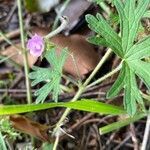A herb which keeps growing from year to year. It can lie along the ground or be slightly upright. It can be 40 cm high. The stems are coarsely hairy. They are 50 cm long and arise from a swollen taproot. They can root at the nodes. The leaves are 1-3 cm long and 2-5 cm across. They are divided into 5-10 lobes. Each lobe is again divided or toothed near the tip. The leaves at the base are larger. The flowers are pink and spreading. They are 1.5 cm across. There are 5 overlapping petals and the centre is more pale. They occur in pairs on slender stalks 5 cm long. The fruit is beaked and 2.5 cm long.

